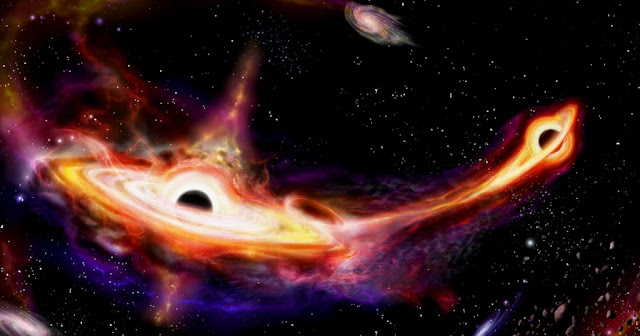Mind-Blowing Collision: Astronomers Can't Wait to Witness Giant Black Holes Smash Together
Space, often referred to as the final frontier, continues to captivate us with its vastness and unknown wonders. As our scientific understanding and technological capabilities advance, we are gradually unveiling the secrets hidden within the cosmos. Black holes, one of the most enigmatic phenomena in space, remain partially elusive to scientists.
 |
| Mind-Blowing Collision: Astronomers Can't Wait to Witness Giant Black Holes Smash Together |
However, even without complete comprehension, scientists are utilizing advanced instruments to gather copious amounts of data by observing distant collisions between black holes. In this article, we explore the fascinating discoveries made by astronomers using NASA’s Chandra X-ray Observatory, focusing on the merging dwarf galaxies located millions and billions of light years away.
Exploring the Merging Dwarf Galaxies
The Astounding Findings
Astronomers have successfully monitored the merging of two dwarf galaxies situated at mind-boggling distances—760 million and 3.2 billion light years away—through the remarkable capabilities of NASA’s Chandra X-ray Observatory. These observations have led to groundbreaking discoveries, establishing the first-ever evidence of merging dwarf galaxies. Previously, black hole collisions had been predominantly observed in large galaxies in close proximity. However, detecting such events in dwarf galaxies posed significant challenges, and all previous attempts had proven unsuccessful.
The Significance of Dwarf Galaxies
Dwarf galaxies play a pivotal role in understanding the evolution of galaxies as a whole. Cosmologists propose that numerous dwarf galaxies have merged over vast periods, ultimately giving rise to the large galaxies we observe today. Considering their historical importance, dwarf galaxies can be viewed as our galactic ancestors that have undergone billions of years of evolution, ultimately contributing to the formation of galaxies like our very own Milky Way.
Despite their significance, studying dwarf galaxies remains an arduous task. Their distant locations and relatively small sizes make them difficult to observe and comprehend fully. However, the recent observation of four merging black holes within dwarf galaxies has reignited scientific enthusiasm. This groundbreaking discovery promises to unlock further insights into the intricate nature of these celestial bodies and inspire continued observation and analysis for years to come.
Conclusion
The mysteries surrounding space and black holes persist, captivating the imaginations of scientists and enthusiasts alike. Although our comprehension of black holes may be incomplete, advancements in scientific instruments, such as NASA’s Chandra X-ray Observatory, allow us to delve deeper into the secrets of the universe. By monitoring the collisions of black holes within merging dwarf galaxies, astronomers have made groundbreaking discoveries, expanding our understanding of galactic evolution. Dwarf galaxies, considered the ancestors of larger galaxies, have played a crucial role in shaping our universe over billions of years. As we continue to explore the cosmos, the merging of black holes within dwarf galaxies promises to unveil more extraordinary revelations.
FAQs (Frequently Asked Questions)
1. How do astronomers observe black hole collisions within dwarf galaxies?
Astronomers employ advanced instruments like NASA’s Chandra X-ray Observatory to monitor the collisions of black holes within merging dwarf galaxies, gathering crucial data for analysis.
2. Why are dwarf galaxies significant in studying galactic evolution?
Dwarf galaxies offer insights into the evolutionary processes of galaxies as a whole. Scientists believe that many dwarf galaxies have merged over time, eventually forming the larger galaxies observed today.
3. Why are black hole collisions in dwarf galaxies challenging to detect?
Detecting black hole collisions within dwarf galaxies is challenging due to their distant locations and relatively small sizes, making them difficult to observe and study.
4. What role do dwarf galaxies play in the formation of galaxies like the Milky Way?
Dwarf galaxies are considered galactic ancestors that have evolved over billions of years, contributing to the formation of larger galaxies like our Milky Way.
5. How will the observation of merging black holes in dwarf galaxies impact future research?
The observation of black hole mergers within dwarf galaxies provides exciting avenues for further research, enabling scientists to draw new conclusions and deepen our understanding of these cosmic phenomena.


Awesome blog Thank you for sharing the Great information.. Useful and Well explained..
Nice post by the way. I loved the article very much. It was so informative and interesting
https://www.alternativeinvestmentopportunities.com/
Excellent blog…this article is very helpful for all of us…